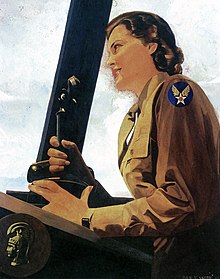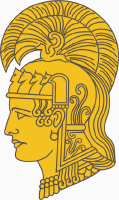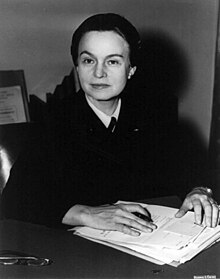Women's Army Corps: Difference between revisions
→Slander campaign: tweaks |
→Evaluations: quote |
||
| Line 33: | Line 33: | ||
General [[Douglas MacArthur]] called the WACs "my best soldiers", adding that they worked harder, complained less, and were better disciplined than men.<ref>{{harvnb|Treadwell|1954|p=460}}</ref> Many generals wanted more of them and proposed to draft women but it was realized that this "would provoke considerable public outcry and Congressional opposition", and so the War Department declined to take such a drastic step.<ref>{{harvnb|Treadwell|1954|pp=95–96}}</ref> Those 150,000 women who did serve released the equivalent of 7 divisions of men for combat. Gen. Dwight D. Eisenhower said that "their contributions in efficiency, skill, spirit, and determination are immeasurable".<ref>{{harvnb|Treadwell|1954|p=408}}</ref> Nevertheless the slander campaign hurt the reputation of the WAC and WAVES; women did not want it known they were veterans.<ref>Campbell, p 45</ref> |
General [[Douglas MacArthur]] called the WACs "my best soldiers", adding that they worked harder, complained less, and were better disciplined than men.<ref>{{harvnb|Treadwell|1954|p=460}}</ref> Many generals wanted more of them and proposed to draft women but it was realized that this "would provoke considerable public outcry and Congressional opposition", and so the War Department declined to take such a drastic step.<ref>{{harvnb|Treadwell|1954|pp=95–96}}</ref> Those 150,000 women who did serve released the equivalent of 7 divisions of men for combat. Gen. Dwight D. Eisenhower said that "their contributions in efficiency, skill, spirit, and determination are immeasurable".<ref>{{harvnb|Treadwell|1954|p=408}}</ref> Nevertheless the slander campaign hurt the reputation of the WAC and WAVES; women did not want it known they were veterans.<ref>Campbell, p 45</ref> |
||
During the same time period, other branches of the U.S. military had similar women's units, including the Navy [[WAVES]], the [[SPARS]] of the Coast Guard, and the (civil) [[Women Airforce Service Pilots]]. The British Armed Forces also had similar units, including the [[Women's Auxiliary Air Force]]. |
During the same time period, other branches of the U.S. military had similar women's units, including the Navy [[WAVES]], the [[SPARS]] of the Coast Guard, and the (civil) [[Women Airforce Service Pilots]]. The British Armed Forces also had similar units, including the [[Auxiliary Territorial Service]] and the [[Women's Auxiliary Air Force]]. |
||
According to historian D'Ann Campbell, American society was not ready for women |
|||
in military roles: |
|||
:The WAC and WAVES had been given an impossible mission: they not only had to raise a force immediately and voluntarily from a group that had no military traditions, but also had overcome intense hostility from their male comrades. The situation was highly unfavorable: the women had no clear purpose except to send men to the battlefront; duties overlapped with civilian employees and enlisted male coworkers, causing confusion and tension; and the leadership cadre was unprestigious, inexperienced, and had little control over women, none over men. Although the military high command strongly endorsed their work, there were no centers of influence in the civilian world, either male or female, that were committed to the success of the women's services, and no civilian institutions that provided preliminary training for recruits or suitable positions for veterans. Wacs, Waves, Spars and women Marines were war orphans whom no one loved.<ref>Campbell, p 49</ref> |
|||
==Disbanded== |
==Disbanded== |
||
Revision as of 01:12, 16 December 2014



The Women's Army Corps (WAC) was the women's branch of the United States Army. It was created as an auxiliary unit, the Women's Army Auxiliary Corps (WAAC) on 15 May 1942 by Public Law 554,[1] and converted to full status as the WAC on 1 July 1943. Its first director was Oveta Culp Hobby, a prominent society woman in Texas.[2][3]
History
The WAAC's organization was designed by numerous Army bureaus coordinated by Lt. Col. Gilman C. Mudgett, the first WAAC Pre-Planner; however, nearly all of his plans were discarded or greatly modified before going into operation because he expected a corps of only 11,000 women.[4] Without the support of the War Department, Representative Edith Nourse Rogers of Massachusetts introduced a bill on 28 May 1941, providing for a women’s army auxiliary corps. The bill was held up for months by the Bureau of the Budget but was resurrected after the United States entered the war and became law on 15 May 1942. A section authorizing the enlistment of 150,000 volunteers was temporarily limited by executive order to 25,000.[5]
The WAAC was modeled after comparable British units, especially the ATS, which caught the attention of Chief of Staff George C. Marshall.[6] In 1942, the first contingent of 800 members of the Women's Army Auxiliary Corps began basic training at Fort Des Moines Provisional Army Officer Training School, Iowa. The women were fitted for uniforms, interviewed, assigned to companies and barracks and inoculated against disease during the first day.[7]



A physical training manual titled "You Must Be Fit" was published by the War Department in July 1943, aimed at bringing the women recruits to top physical standards. The manual begins by naming the responsibility of the women: "Your Job: To Replace Men. Be Ready To Take Over."[8] It cited the commitment of women to the war effort in England, Russia, Germany and Japan, and emphasized that the WAC recruits must be physically able to take on any job assigned to them. The fitness manual was state-of-the-art for its day, with sections on warming up, and progressive body-weight strength-building exercises for the arms, legs, stomach, and neck and back. It included a section on designing a personal fitness routine after basic training, and concluded with "The Army Way to Health and Added Attractiveness" with advice on skin care, make-up, and hair styles.[8]
Inept publicity and the poor appearance of the WAAC/WAC uniform, especially in comparison to that of the other services, handicapped recruiting efforts. A resistance by senior Army commanders was overcome by the efficient service of WAACs in the field, but the attitude of men in the rank and file remained generally negative and hopes that up to a million men could be replaced by women never materialized. The United States Army Air Forces became an early and staunch supporter of regular military status for women in the Army.[5]
About 150,000[9] American women eventually served in the WAAC and WAC during World War II. They were the first women other than nurses to serve with the Army.[10] While conservative opinion in the leadership of the Army and public opinion generally was initially opposed to women serving in uniform, the shortage of men necessitated a new policy. While most women served stateside, some went to various places around the world, including Europe, North Africa, and New Guinea. For example, WACs landed on Normandy Beach just a few weeks after the initial invasion.[11]
Slander campaign
In 1943 the recruiting momentum stopped and went into reverse as a massive slander campaign on the home front challenged the Wacs as sexually immoral.[12] Many soldiers ferociously opposed allowing women in uniform, warning their sisters and friends they would be seen as lesbians or prostitutes. Their lewd humor and snide comments betrayed a fear that if women became soldiers they would no longer serve in a masculine preserve and their masculinity would be devalued.[13] Other men, seeing the posters that called on women to volunteer in order to "Free a Man to Fight" feared being sent into combat units if women took the safe jobs. All investigations showed the rumors were false, but they had originated with American soldiers, not with enemy agents.[14]
Evaluations
General Douglas MacArthur called the WACs "my best soldiers", adding that they worked harder, complained less, and were better disciplined than men.[15] Many generals wanted more of them and proposed to draft women but it was realized that this "would provoke considerable public outcry and Congressional opposition", and so the War Department declined to take such a drastic step.[16] Those 150,000 women who did serve released the equivalent of 7 divisions of men for combat. Gen. Dwight D. Eisenhower said that "their contributions in efficiency, skill, spirit, and determination are immeasurable".[17] Nevertheless the slander campaign hurt the reputation of the WAC and WAVES; women did not want it known they were veterans.[18]
During the same time period, other branches of the U.S. military had similar women's units, including the Navy WAVES, the SPARS of the Coast Guard, and the (civil) Women Airforce Service Pilots. The British Armed Forces also had similar units, including the Auxiliary Territorial Service and the Women's Auxiliary Air Force.
According to historian D'Ann Campbell, American society was not ready for women in military roles:
- The WAC and WAVES had been given an impossible mission: they not only had to raise a force immediately and voluntarily from a group that had no military traditions, but also had overcome intense hostility from their male comrades. The situation was highly unfavorable: the women had no clear purpose except to send men to the battlefront; duties overlapped with civilian employees and enlisted male coworkers, causing confusion and tension; and the leadership cadre was unprestigious, inexperienced, and had little control over women, none over men. Although the military high command strongly endorsed their work, there were no centers of influence in the civilian world, either male or female, that were committed to the success of the women's services, and no civilian institutions that provided preliminary training for recruits or suitable positions for veterans. Wacs, Waves, Spars and women Marines were war orphans whom no one loved.[19]
Disbanded
The WAC as a branch was disbanded in 1978 and all female units were integrated with male units. Women serving as WACs at that time converted in branch to whichever Military Occupational Specialty they worked in. Since then, women in the US Army have served in the same units as men, though they have only been allowed in or near combat situations since 1994 when Defense Secretary Les Aspin ordered the removal of "substantial risk of capture" from the list of grounds for excluding women from certain military units.
List of Directors
| • | Colonel Oveta Culp Hobby | (1942–1945) | |
| • | Colonel Westray Battle Boyce | (1945–1947) | |
| • | Colonel Mary A. Hallaren | (1947–1953) | |
| • | Colonel Irene O. Galloway | (1953–1957) | |
| • | Colonel Mary Louise Milligan Rasmuson | (1957–1962) | |
| • | Colonel Emily C. Gorman | (1962–1966) | |
| • | Brigadier General Elizabeth P. Hoisington | (1966–1971) | |
| • | Brigadier General Mildred Inez Caroon Bailey | (1971–1975) | |
| • | Brigadier General Mary E. Clarke | (1975–1978) |

Louisiana Register of State Lands Ellen Bryan Moore attained the rank of captain in the WACs and once recruited three hundred women at a single appeal to join the force.[20]
Popular culture
- The 1945 film Keep Your Powder Dry features Lana Turner joining the WACs, which starred Agnes Moorehead, while sporting uniforms designed by Hollywood designer Irene and hair styled by Sydney Guilaroff.
- The 1949 film I Was a Male War Bride depicts Cary Grant as a French officer who married an American WAC, played by Ann Sheridan and their escapades as he attempts to emigrate to the United States under the auspices of the 1945 War Brides Act.
- The 1954 film Francis Joins the WACS stars Francis the Talking Mule, who joins the Women's Army Corps.
- General Blankenship's secretary, Corporal Etta Candy (Beatrice Colen) in the first season of Wonder Woman was a WAC veteran.
- The song Surrender by Cheap Trick is about a babyboomer child of a former member of the WAC who served in the Philippines.
- Mare's War, a novel by Tanita S. Davis, centers around an African-American girl who joins the WAC.
- On an episode of The Looney Tunes Show, Granny tells Daffy Duck a story where she served as a WAC and prevented the theft of the Eiffel Tower and numerous artworks from The Louvre.
- Miss Grundy, a teacher in the Archie Comics series, was a WAC.
- The Phil Silvers Show makes numerous references to the WACs. Several of the supporting cast, such as Sgt. Joan Hogan (Elisabeth Fraser), are members of the WAC and many of the gags and jokes in the show revolve around woman in the army.
Women's Army Corps Veterans' Association
The Women's Army Corps Veterans' Association was organized to serve those who have served honorably with the Women's Army Auxiliary Corps, The Women's Army Corps, or those who have served or are serving honorably in the United States Army, the United States Army Reserve or the Army National Guard of the United States. [21]
See also
- Air Transport Auxiliary
- Army Women's Museum
- Women in the Air Force (WAF)
- Women in the military
- Women's Army Volunteer Corp
References
- ^ Moore, Brenda. (1996). To Serve My Country, To Serve My Race. New York: New York University Press.
- ^ Treadwell 1954, pp. 28–30
- ^ Meyer 1996, pp. 16–18
- ^ Treadwell 1954, pp. 26–28
- ^ a b Craven & Cate 1953, p. xxxvi
- ^ Bernard A. Cook, Women and war: a historical encyclopedia from antiquity to the present (2006) Volume 1 p. 242
- ^ Treadwell, 1954 & ch 3–4
- ^ a b W. A. C. Field Manual Physical Training" (FM 35-20). War Department, 15 July 1943. United States Government Printing Office, Washington, D.C.
- ^ Bellafaire 1972, p. 2
- ^ Video: American Army Women Serving On All Fronts Etc. (1944). Universal Newsreel. 1944. Retrieved 21 February 2012.
- ^ Treadwell 1954, pp. 387–388
- ^ Leisa D. Meyer (1998). Creating G. I. Jane: Sexuality and Power in the Women's Army Corps During World War II. Columbia University Press. pp. 33–51.
- ^ Campbell, ch 1
- ^ Treadwell 1954, p. 184
- ^ Treadwell 1954, p. 460
- ^ Treadwell 1954, pp. 95–96
- ^ Treadwell 1954, p. 408
- ^ Campbell, p 45
- ^ Campbell, p 49
- ^ "Interview with Ellen Bryan Moore". T. Harry Williams Center for Oral History, Louisiana State University at Baton Rouge, Louisiana. September–October 1995.
- ^ http://www.armywomen.org/aboutUs.shtml
Bibliography
- Bellafaire, Judith A. (1972). The Women's Army Corps: A Commemoration of World War II Service. Washington, DC: United States Army Center of Military History. CMH Publication 72-15.
- Campbell, D'Ann (1986). Women at War with America: Private Lives in a Patriotic Era. Harvard University Press. ISBN 0-674-95475-0.
- Craven, Wesley Frank, and Cate, James Lea, editors (1958). The Army Air Forces In World War II, Volume Seven - Services Around the World, Air Force Historical Studies Office
- Holm, Jeanne (1994). Women in the Military: An Unfinished Revolution. Presidio Press. ISBN 0-89141-450-9., popular history
- Meyer, Leisa D. (1992). Creating GI Jane: Sexuality and Power in the Women's Army Corps During World War II. Columbia University Press. ISBN 0-231-10145-7.
- Morden, Bettie J. (2000). The Women's Army Corps, 1945–1978. United States Army Center of Military History. CMH Pub 30-14., scholarly history of postwar era
- Putney, Martha S. (1992). When the Nation Was in Need: Blacks in the Women's Army Corps During World War II. The Scarecrow Press. ISBN 0-8108-4017-0.
- Treadwell, Mattie E. (1954). The Women's Army Corps. United States Army in World War II (1991 ed.). United States Army Center of Military History. – full text; the standard scholarly history
Memoirs
- Samford, Doris E (1966). Ruffles and Drums. Pruett Press, Boulder, Colorado. ASIN B0006BP2XS.
- Earley, Charity Adams (1989). One Woman's Army: A Black Officer Remembers the WAC. Texas A&M University Press. ISBN 0-89096-694-X.
- Moore, Brenda L. (1996). To Serve My Country, to Serve My Race: The Story of the Only African-American WACs Stationed Overseas during World War II. New York University Press. ISBN 0-8147-5587-9.
- Starbird, Ethel A. (2010). When Women First Wore Army Shoes: A first-person account of service as a member of the Women's Army Corps during WWII. iUniverse. ISBN 1-4502-0893-2.
External links
- Official website
- Women in Army History at the United States Army Center of Military History
- WAAC/WAC history and WWII women's uniforms in color – World War II US women's service organizations (WAC, WAVES, ANC, NNC, USMCWR, PHS, SPARS, ARC and WASP)
- Women Veterans Historical Collection – digitized letters, diaries, photographs, uniforms, and oral histories from WACs
- Papers of Fran Smith Johnson, WAC, Dwight D. Eisenhower Presidential Library
- The Slander Campaign book chapter by Ann Elizabeth Pfau
- WWII: Women in the Fight – slideshow by Life magazine
- World War II uniform, Women’s Army Air Force, in the Staten Island Historical Society Online Collections Database
- Oral history interview with Gladys Donovan, a WAC from 1943–1946 from the Veterans History Project at Central Connecticut State University
- The WAC: The Story of the WAC in the ETO
- The short film Big Picture: The WAC is a Soldier, Too is available for free viewing and download at the Internet Archive.
- The short film It's Your War Too (1944) is available for free viewing and download at the Internet Archive.
- A film clip ALLIES TAKE KISKA ETC. (1943) is available for viewing at the Internet Archive
- Use dmy dates from May 2011
- Branches of the United States Army
- Women in the United States Army
- Women in World War II
- American women in World War II
- All-female military units and formations
- Military units and formations established in 1942
- Military units and formations disestablished in 1942
- 1942 establishments in the United States
- 1978 disestablishments in the United States
- Military history of the United States during World War II
- Sex segregation

